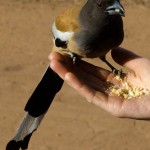It was Sunday, February 7th and I was perched on my doghouse in Chena, Alaska. Among the dozens of other tail-wagging, tongue-panting, treat-seeking, barking mongrels hanging out in the bright sunlight of a frigid wintry afternoon….there I was, waiting my turn. As  I scanned the collection of wooden dog houses and all my furry friends hovering around, each and every set of K9 eyes looked at each and every set of homo sapiens, expressing to the extent by which dogs can express, “Pick me! Pick me!”
I scanned the collection of wooden dog houses and all my furry friends hovering around, each and every set of K9 eyes looked at each and every set of homo sapiens, expressing to the extent by which dogs can express, “Pick me! Pick me!”
I was born the offspring of lab/shepherd mix and a teenage mutant ninga hound. Some kind of every dog species was somewhere in my DNA, making me a wonderful mix of strength, endurance, and appetite. Because I’ve been crissed and cross breeded and with the best of the best, I am a devoted and loving pup – eager to please my human friends by running fast, playing nice and looking so darned cute for all those tourists who come visit me every day.
Usually these visits are a collection of ooohs’ and awwww’s with a little rub here and a little pat there…here an ooooh, there an awwwww…everywhere a pat pat. But today….something different happened.  I woke up along with my litter of friends, just a little happier and excited to start the day. Just a little more eager to please. Just a little more full of anticipation.
I woke up along with my litter of friends, just a little happier and excited to start the day. Just a little more eager to please. Just a little more full of anticipation.
I soon found out why.
Amazing Journeys was coming!!
At precisely 11am the first group showed up and the “Pick me, Pick me” looks and barks started emitting from every dog house on the block. I wasn’t picked…but that was ok because that meant that I could watch all the fun and host a visitor or two to my pen. I had prepared my doghouse for visitors early that day by peeing on each and every corner of my dwelling. I even laid a dump on the back wall just so everything would be perfect. While that first group giddy-upped into the wilderness with Cecil, Hansel, Moonshine, Stevie, Lucy, Buster and Chester….the next group of humans came to play.
Wobbling up the road like abominable snowmen, they marched. I don’t mean to sound crass but as I lay around town in my winter fur—and just my winter fur—these city folk were bundled up more tightly than a set of tefillin on the arm of a chasidic rabbi. I overheard a couple of them “bragging” about how many layers they had on. One lady had—get this—long underwear, short underwear, two t-shirts, thermal socks, a sweater, a vest, a fleece, a scarf, ear muffs, a hat, a hood…and something they kept calling a baklava. Us four-legged creatures had a good howl later in the day with all the kinfolk. Hellooooo,…look at us; one layer and happy as a clam.
 While my comrades ran I had the day off to play with the humans. I got ear massages, tummy rubs, and back scratches for two straight hours…and then I got to have lunch and take a nap. All without ever leaving my home.
While my comrades ran I had the day off to play with the humans. I got ear massages, tummy rubs, and back scratches for two straight hours…and then I got to have lunch and take a nap. All without ever leaving my home.
My next door neighbor, Baily told me a great story about this Amazing Journeys group from the day before. See, we have eyes and ears…and noses all around this great land of Alaska. While this group called Amazing Journeys was chugging around on snow mobiles we were howling at their adventures. Poor Master Pete who had to lead the way for them was beside himself with worry and concern. Pete, who could sing to the Aurora Borealis, couldn’t snow mobile bad enough with this group to make him look good.  One person gave up mid-ride and had to be snow lifted home….one girl steered her snow machine off the side of a trail into an 8 foot bank and had to hauled upright thankfully unharmed.
One person gave up mid-ride and had to be snow lifted home….one girl steered her snow machine off the side of a trail into an 8 foot bank and had to hauled upright thankfully unharmed.
THEN, there was the woman they call Annie. I’ve never heard our commands used for humans, but suddenly it was “Come Hau Annie…Come Hau”. We don’t know what really happened, but Rusty, who has his nose in everyone’s crotch seems to think she took a wrong turn somewhere in the wilderness and had to walk back when no one noticed she was missing.
Meanwhile, this group just loved our small town of Chena and all the activities they could play. More ooohs’ and awww’s as they treated themselves to the hot springs, drank martini’s in our famous ice museum, rocked & rolled in the snow coaches for sunset views atop the mountain… and gazed endlessly at the night sky for the northern lights.
When it was time for this group to go, it felt like loading up a carload of us pups to head to the vet. No one wanted to go. But, they were on a quest for the best day of the trip so far, so off they went.
I heard from my cousins Big Boy and Sunny Girl that AJ stopped by to see their Master Mary Shields and her brood. What a special place with a special lady; she’s the first woman ever to have finished the world renowned Iditarod Sled Dog Race. I’m told that Mary treats her family of dogs abundantly special and that her loved ones are some of the happiest healthiest dogs in Alaska. I hear from Big Boy that she bakes her own dog treats for the family….along with a mean chowder and the sweetest brownies for the guests.  I’m told that Mary loves to tell her stories and that the humans love to hear them. Some of my ancestors are mentioned in her stories and I’m proud to say that I am an Alaskan Sled Dog because of them.
I’m told that Mary loves to tell her stories and that the humans love to hear them. Some of my ancestors are mentioned in her stories and I’m proud to say that I am an Alaskan Sled Dog because of them.
One of my great great uncles was honored this year at the World Ice Carving Competition. The ice artists from Norway incorporated my Uncle Rico into one of their sculptures. I understand that this ice festival is a sight to behold with dazzling sculptures, interactive designs and spectacular artistry.
My butt-sniffing friend Misty went to the festival last year with her owner Miss Melinda and gave the ice festival a perfect 5 wags of the tail. Miss Melinda is a really cool Canadian lady who raises mushing dogs; some who are noted for continuing the lineage of Balto, the most famous sled dog of all time who lead the way in 1925 delivering diphtheria antitoxin to Nome.  Balto is accredited for paving the way for what is now the famous Iditarod Race and is honored with a statue at the starting line of the Iditarod on 4th Street.
Balto is accredited for paving the way for what is now the famous Iditarod Race and is honored with a statue at the starting line of the Iditarod on 4th Street.
Misty told me of some crazy antics that happen on Iditarod Day.  There is a huge gathering of people on 4th Street to watch the start of the race each first Saturday in March. All the teams line up, all the mushers kiss their dogs and wave to the crowd…and then off they go into the great white north.
There is a huge gathering of people on 4th Street to watch the start of the race each first Saturday in March. All the teams line up, all the mushers kiss their dogs and wave to the crowd…and then off they go into the great white north.
After the dogs take off running, so do some crazy people…side by side with reindeer! Hey, I love a good run, but there’s no biscuit in the world that would make me run besides a crazy caribou with pointed horns coming out their heads. Dogs will be dogs…and people will be people, I guess.
Soon spring will be here and much of the ice and snow will melt. Those crazy tourists will keep coming to Chena and Fairbanks and the rest of Alaska, but they’ll eventually start looking less like the Stay Puff Marshmellow Man. But they WILL keep coming…and rightly so-to see the glaciers…to hike the hills…to watch the whales…to fish the salmon… and to escape the crazy world from which they came.
I’m a Sled Dog and proud to say, Alaskan. This great land of ours is magical and mysterious. Its laden with a sense of adventure and a lore that has to be experienced, not just explained. I’ve been privileged to run through a few fields around the land, but the stories told by my ancestors tell a tale of unbelievable possibilities & realities that this land is famous for. We call her Mother Nature’s Showcase. I call her home.














































